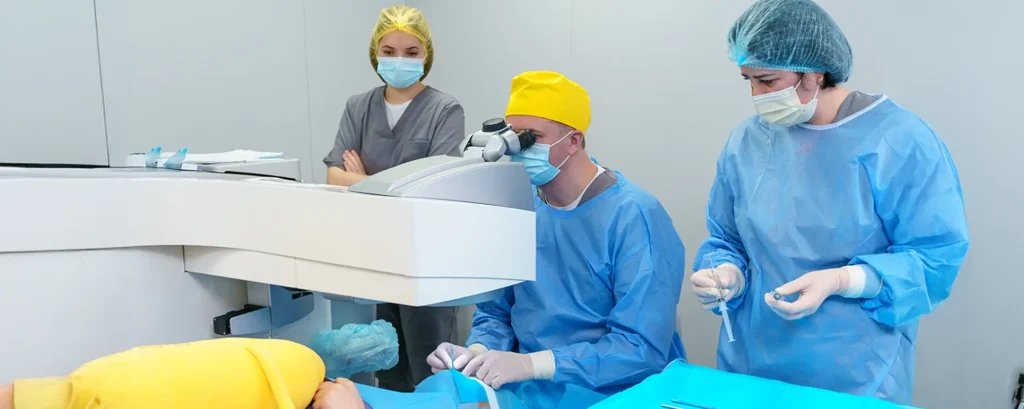If you’ve ever heard the term “posterior polar cataract” and felt a flicker of concern—whether you’re a surgeon or a patient—you’re not alone. This type of cataract may be rare, but it certainly makes up for it in complexity. And if you’re a cataract surgeon, this is the case where you really earn your stripes.
Let’s break it down together. In this article, we’re going to explore what makes posterior polar cataracts so tricky, why a standard approach just won’t cut it, and what modern research suggests we do instead. Whether you’re preparing for surgery or just curious about the finer points of cataract management, you’re in the right place.
What Exactly Is a Posterior Polar Cataract?
Let’s start with the basics. A posterior polar cataract (PPC) is a type of cataract located at the back of the lens—right in the central posterior capsule. That’s important, because the posterior capsule is like the cling film of the eye’s lens. It’s extremely thin and delicate. In cases of PPC, there’s not just clouding of the lens; the capsule itself is often weak, thin, or even pre-existingly dehiscent (that’s medical speak for a tear that’s already there).
These cataracts are often congenital, meaning the patient was born with them or developed them early in life. They can remain stable for years or slowly worsen over time. Unlike nuclear or cortical cataracts, which are usually related to ageing or systemic health issues, posterior polar cataracts are typically less about lifestyle and more about genetic predisposition or developmental anomalies.
From a visual perspective, they tend to cause more pronounced central vision problems even when they’re relatively small. Patients often complain of glare and difficulty reading, especially in bright light. But from a surgical standpoint, the real headache isn’t what they look like—it’s what they do to the posterior capsule.
Why Are They So Risky to Remove?
Here’s the part that makes cataract surgeons sit up straight: posterior polar cataracts have a high risk of posterior capsule rupture during surgery. Some studies estimate the rupture risk to be as high as 26–36%, particularly if standard hydrodissection techniques are used. That’s not a statistic anyone wants to hear.
The problem is the anatomy. In a typical cataract, the posterior capsule is robust enough to tolerate the fluid waves generated during hydrodissection—a standard step in most phacoemulsification surgeries. But in PPC cases, that same technique can tear the capsule like tissue paper. In some eyes, the capsule is already partially open before the surgeon even gets started.
That changes everything. The surgeon has to be gentle, deliberate, and extremely cautious. It’s not about bravado or speed; it’s about surgical respect for a fragile structure. Every step must be reconsidered, from the capsulorhexis to nuclear removal and IOL implantation.
The Role of Imaging Before Surgery
Let’s talk diagnostics. Preoperative imaging plays a crucial role in planning PPC surgery. The goal? Identify any existing posterior capsule dehiscence before a single instrument touches the eye.
Optical coherence tomography (OCT) and Scheimpflug imaging are particularly useful. With OCT, you can get a cross-sectional view of the lens and see if the posterior capsule is intact or not. High-resolution slit-lamp photography also helps, especially if combined with careful history-taking. Ask patients about long-standing glare or whether the opacity was noticed in childhood—these clues often point to a congenital PPC.
But here’s the catch: even with the best imaging, you can’t always tell if the capsule is intact. That’s why a cautious approach is mandatory no matter what the scans show. Imaging can guide you, but it can’t eliminate the risk entirely.
To Hydrodissect or Not to Hydrodissect?
This is the million-pound question in PPC surgery. Traditional hydrodissection is almost universally avoided in posterior polar cataracts. The pressure generated by fluid injection can blow a weak posterior capsule wide open.
Instead, surgeons often use hydrodelineation—a gentler method that separates the nuclear core from the surrounding epinucleus without disturbing the posterior capsule. Think of it like peeling an orange from the inside out rather than blasting it with a hosepipe. You still get the separation you need, but without the same risk of rupture.
Some surgeons skip fluid-based techniques entirely and rely on careful mechanical rotation to mobilise the nucleus. Others inject minimal fluid centrally and watch like hawks for any sign of posterior capsule tenting. The technique must be tailored not just to the eye, but to what you find as you go. There’s no one-size-fits-all here.
Modified Phaco Techniques for Posterior Polar Cataracts

Standard divide-and-conquer? Not here. In PPC surgery, you’re more likely to see techniques like phaco chop or stop-and-chop, but with significant modifications.
Some surgeons opt for inside-out delineation, where you carefully hollow out the central nucleus and then chip away at the peripheral parts. This reduces traction on the capsule. Others go for a viscodissection-assisted approach, where ophthalmic viscosurgical devices (OVDs) are used to gently separate layers of the lens without any aggressive manipulation.
Using low phaco energy, slow aspiration rates, and minimal bottle height can also reduce turbulence and pressure fluctuations inside the eye. The key is finesse over force. Every movement should be deliberate and controlled.
If the posterior plate is extremely adherent—as it often is—you might need to leave a thin rim of epinucleus behind and aspirate it cautiously later. The priority is maintaining the integrity of the capsule for safe IOL placement.
Handling an Intraoperative Capsule Rupture
Let’s say the worst happens. The capsule gives way mid-surgery. What next?
First—don’t panic. The most important thing is to stabilise the anterior chamber. Inject a dispersive OVD to maintain space and tamponade the rupture. Then assess the extent of the damage. If vitreous has prolapsed into the anterior chamber, you’ll need a careful anterior vitrectomy.
Posterior polar cataracts often come with an unusually adherent posterior plaque. If this peels away during surgery, you might be left with a gaping defect. In such cases, a sulcus IOL with optic capture may be your best bet. If the tear is small and well centred, you might still be able to implant a single-piece lens in the bag—though that’s the exception rather than the rule.
This is where your surgical judgement and experience really count. Knowing when to press on and when to change course is what defines a good outcome.
Intraoperative OCT: A Real-Time Ally
In recent years, intraoperative OCT has emerged as a powerful tool in PPC surgery. It allows the surgeon to visualise the posterior capsule in real time during each step of the procedure. You can see whether fluid is building up dangerously or whether the capsule is being tented.
It’s especially helpful during phacoemulsification and epinucleus removal. Surgeons can detect subtle signs of capsule stress before an actual rupture occurs. This gives you a chance to modify your technique on the fly—slowing down, changing angles, or switching to a more conservative approach.
The evidence so far suggests that intraoperative OCT may reduce the rate of posterior capsule rupture, though larger studies are still needed. Either way, for complex cases like these, the extra insight is well worth it.
Posterior Capsular Plaques: To Polish or Not?
A common finding in PPC is the presence of dense, fibrotic plaques on the posterior capsule. These often remain after the cataract material is removed, sitting right in the visual axis.
The big question is whether to try and remove them. Polishing can be risky, especially with a fragile capsule. If the plaque is thin, gentle aspiration with a bimanual I/A probe may work. But in many cases, surgeons choose to leave the plaque in place and deal with it postoperatively using a YAG laser capsulotomy once the eye has healed.
This delayed approach is often safer and gives the surgeon more control. It’s a good example of the adage: sometimes, less is more—especially when dealing with tissue that’s already compromised.
Choosing the Right IOL: A Conservative Approach

In PPC cases, simplicity wins. Most surgeons avoid multifocal or toric lenses, particularly if the posterior capsule integrity is uncertain. Monofocal lenses are the safest and most predictable option, especially if sulcus placement becomes necessary.
Acrylic lenses tend to be preferred due to their lower inflammatory potential. If the bag is stable and the rupture is minor, a single-piece hydrophobic acrylic lens can often be implanted without issue. But if there’s any doubt, a three-piece lens in the sulcus with optic capture may be the better route.
Either way, patient counselling is crucial. Set realistic expectations and explain the possible need for additional procedures like a YAG capsulotomy or even a secondary lens if complications arise.
Postoperative Considerations: Recovery and Risks
Postoperative care in PPC cases isn’t all that different from routine cataract surgery—but it does require more vigilance. Watch carefully for signs of posterior capsular opacification (PCO), cystoid macular oedema (CMO), or lens decentration.
Topical steroids and NSAIDs are usually prescribed to reduce inflammation and minimise the risk of CMO. If a YAG laser capsulotomy is needed later, it should only be performed once the eye is fully healed and inflammation is controlled.
The good news? Most patients—despite the risks—do very well if the surgery is handled properly. Visual outcomes are generally excellent, and complications can be managed effectively with timely intervention.
What the Research Says: Data That Matters
A number of clinical studies have examined surgical outcomes in posterior polar cataracts. Meta-analyses show that posterior capsule rupture occurs in 20–30% of cases, even in skilled hands. However, those using hydrodissection routinely see higher complication rates than those using hydrodelineation or viscodissection.
Studies also support the value of intraoperative OCT in reducing posterior capsule complications, especially when used to monitor capsular stress during phaco.
The key takeaway from the research? Surgical technique matters more here than in almost any other type of cataract. And the surgeon’s familiarity with PPC-specific strategies has a direct impact on patient outcomes.
Frequently Asked Questions About Posterior Polar Cataracts
- What makes posterior polar cataracts more difficult to remove than other cataracts?
Posterior polar cataracts sit directly on or very close to the posterior capsule—the thinnest, most delicate part of the lens structure. In many cases, the capsule underneath is already weak or partially torn before surgery even begins. This significantly increases the risk of rupture during cataract removal. Unlike standard cataracts, these cannot be treated with routine techniques like hydrodissection because the fluid pressure can cause the capsule to split. Special care, slower techniques, and modified surgical steps are all essential to reduce the risk of complications. - Can posterior polar cataracts be seen on a routine eye examination?
Yes, most posterior polar cataracts can be identified during a slit-lamp examination by an experienced ophthalmologist. They typically appear as a dense, white, disk-shaped opacity located at the back of the lens. However, what can’t always be seen during a routine check is the condition of the capsule beneath it. That’s why further imaging, such as anterior segment OCT or Scheimpflug photography, is often recommended. These can provide more detailed information and help plan a safer surgical strategy. - Is surgery always required for posterior polar cataracts?
Not necessarily. If the cataract is stable and the patient’s vision is only mildly affected, regular monitoring may be sufficient. Many people with posterior polar cataracts remain symptom-free for years and can manage well with glasses or contact lenses. Surgery is only advised when the cataract begins to interfere significantly with daily activities like reading, driving, or recognising faces. Because of the risks involved, surgeons typically wait until the benefits of removing the cataract clearly outweigh the surgical challenges. - What happens if the posterior capsule ruptures during surgery?
If the capsule tears during surgery, the surgeon will act quickly to stabilise the eye using special viscoelastic substances to maintain pressure and protect the surrounding structures. Depending on the situation, an anterior vitrectomy might be required to clear any prolapsed vitreous. The type and position of the intraocular lens (IOL) may also be adjusted—often placed in the sulcus instead of the capsular bag. While a rupture is not ideal, modern surgical techniques and technologies allow for safe recovery and good visual outcomes in most cases. - Are premium lenses like multifocal or toric IOLs suitable for posterior polar cataract cases?
In general, surgeons approach premium lenses cautiously in posterior polar cataract surgery. Since these lenses require precise positioning and a stable capsule for optimal performance, any compromise to the capsule can affect outcomes. Monofocal lenses are usually preferred because they’re more forgiving if the capsule is fragile or a sulcus placement becomes necessary. If the cataract is bilateral and the other eye is healthy, some patients may still consider a premium lens in the fellow eye, but it should be discussed thoroughly with the surgeon. - How long is the recovery after posterior polar cataract surgery?
Recovery is similar to standard cataract surgery in many cases—most patients notice improvement within a few days to a week. However, due to the added complexity, patients with posterior polar cataracts are followed more closely for signs of complications like inflammation, lens dislocation, or cystoid macular oedema. Some may require additional treatment such as YAG laser capsulotomy if a dense posterior plaque is left behind. Using prescribed eye drops exactly as instructed and attending all follow-up appointments is key to a smooth recovery. - Can posterior polar cataracts come back after surgery?
No, once the natural lens with the cataract is removed, the cataract itself cannot return. However, some patients may develop posterior capsule opacification (PCO), which is a common occurrence after all types of cataract surgery. This is sometimes referred to as a “secondary cataract” but isn’t the same thing. It’s caused by cell regrowth on the capsule behind the new lens and can be treated easily and painlessly with a YAG laser procedure, typically done in clinic with no downtime. - Should I be worried if I’ve been diagnosed with a posterior polar cataract?
Not at all—but it’s important to be informed. Posterior polar cataracts do carry a higher surgical risk compared to more common types, but with careful planning and an experienced surgeon, the outcomes are generally very good. What matters most is that the surgeon recognises the special nature of this cataract and uses the right technique to manage it safely. If you’ve been diagnosed, the best step you can take is to consult a cataract specialist with experience in handling PPC cases.
Final Thoughts
Posterior polar cataracts may be small in appearance, but they’re mighty in surgical complexity. They require a blend of caution, confidence, and creativity. This isn’t a procedure where muscle memory or standard protocols can guide you. Every case is unique, and the margin for error is slim.
But with the right planning, refined techniques, and a deep respect for the anatomy, excellent outcomes are absolutely achievable. If you’re a patient, want to consult with an expert cataract surgeon, make sure you choose someone who understands the nuances of PPC surgery. And if you’re a surgeon, keep your tools sharp, your technique adaptive, and your expectations clear.
Because when it comes to posterior polar cataracts, it’s not about rushing to the finish line—it’s about navigating the path with care.
References
- Vasavada, A.R., Raj, S.M., Shah, G.D., Praveen, M.R., & Vasavada, V.A. (2011) ‘Posterior polar cataracts: a review’, Eye, 25, pp. 115–124. Available at: https://www.nature.com/articles/eye2010147 (Accessed: 28 May 2025).
- Osher, R.H. (1999) ‘Posterior polar cataracts: A surgical challenge’, Journal of Cataract & Refractive Surgery, 25(6), pp. 730–731.
- Lee, M.W., Lee, J.Y., & Kim, J.Y. (2016) ‘Surgical outcomes of posterior polar cataract according to preoperative posterior capsule defect on anterior segment optical coherence tomography’, Graefe’s Archive for Clinical and Experimental Ophthalmology, 254, pp. 243–248.
- Praveen, M.R., Shah, S.K., Vasavada, V.A., Raj, S.M., & Vasavada, A.R. (2011) ‘Preoperative optical coherence tomography and intraoperative findings in posterior polar cataract’, Journal of Cataract & Refractive Surgery, 37(4), pp. 623–627.
- Ashok, L., & Jameel, A. (2022) ‘Posterior polar cataract: clinical characteristics and surgical management’, Indian Journal of Ophthalmology, 70(3), pp. 674–679.

